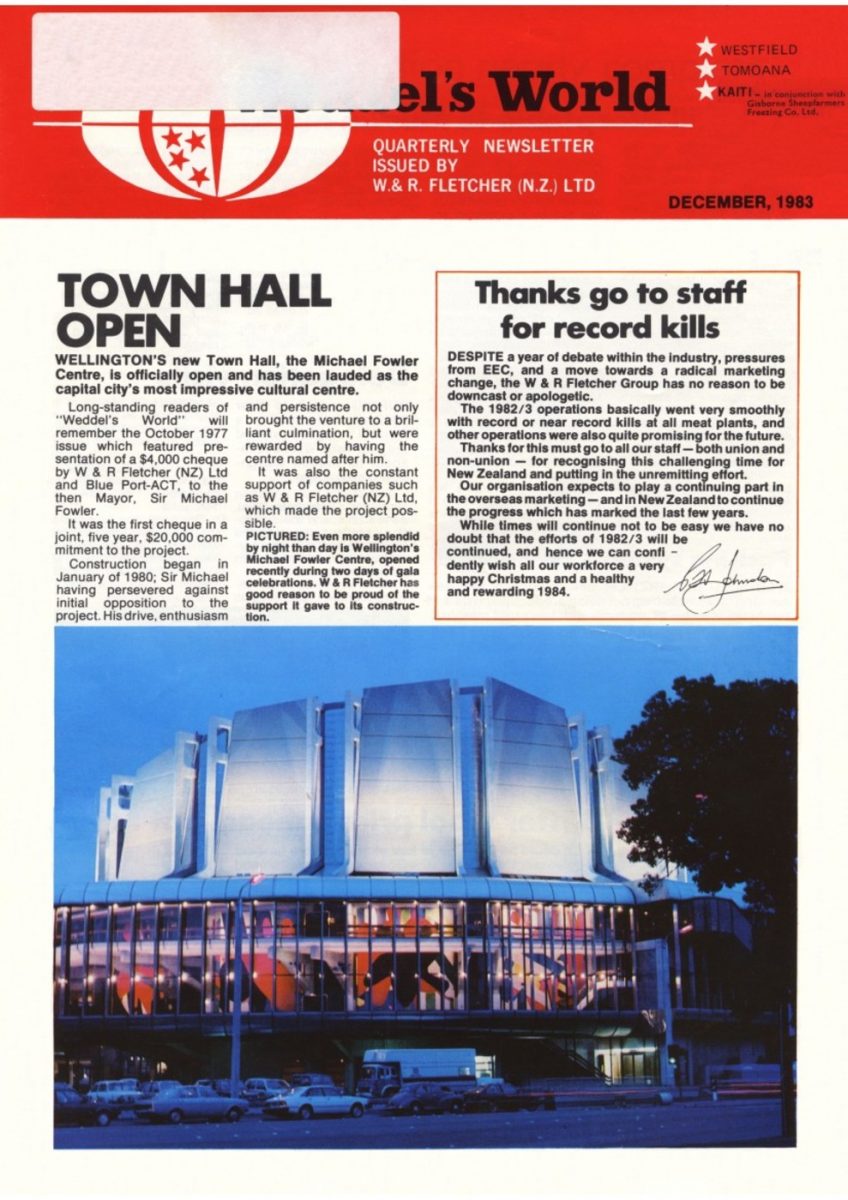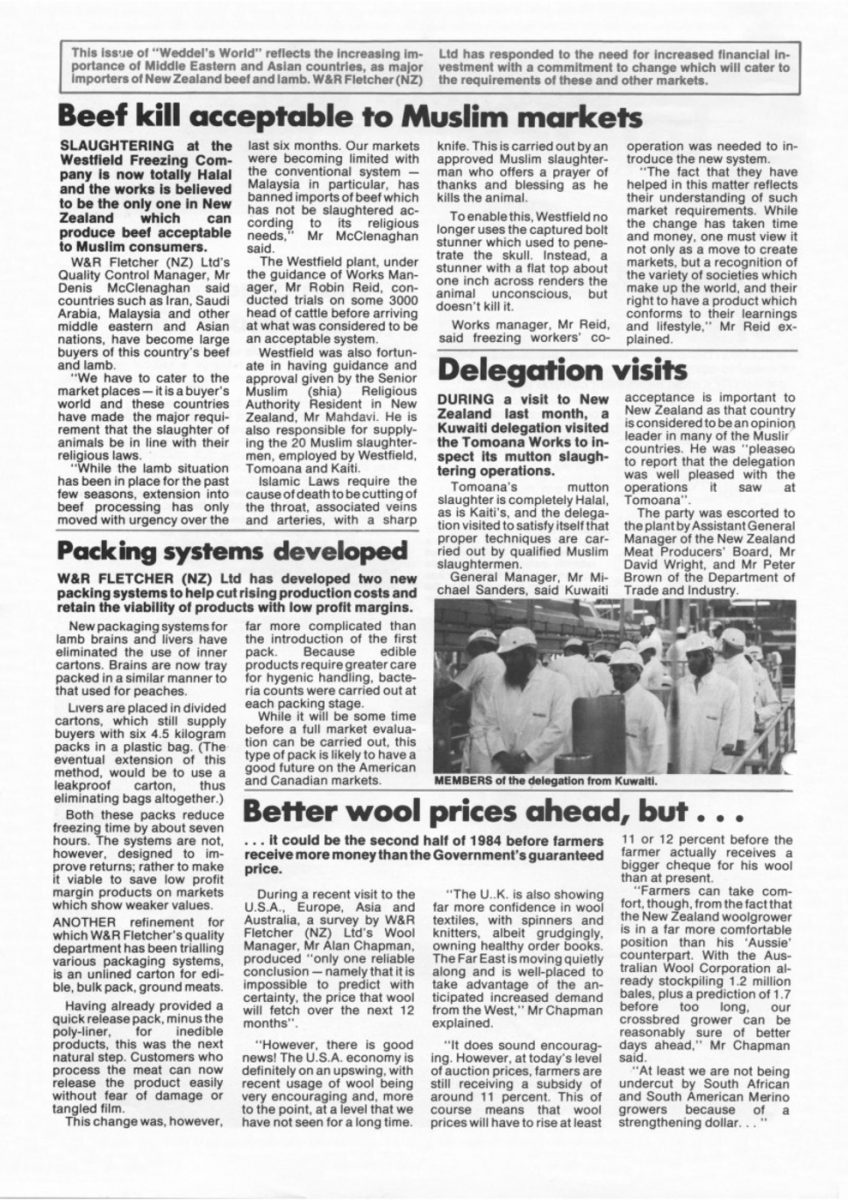This issue of “Weddel’s World” reflects the increasing importance of Middle Eastern and Asian countries, as major importers of New Zealand beef and lamb. W&R Fletcher Ltd has responded to the need for increased financial investment with a commitment to change which will cater to the requirements of these and other markets.
Beef kill acceptable to Muslim markets
SLAUGHTERING at the Westfield Freezing Company is now totally Halal and the works is believed to be the only one in New Zealand which can produce beef acceptable to Muslim consumers.
W&R Fletcher (NZ) Ltd’s Quality Control Manager, Mr Denis McClenaghan said countries such as Iran, Saudi Arabia, Malaysia and other middle eastern and Asian nations, have become large buyers of this country’s beef and lamb,
“We have to cater to the market places – it is a buyer’s world and these countries have made the major requirement that the slaughter of animals be in line with their religious laws.
“While the lamb situation has been in place for the past few seasons, extension into beef processing has only moved with urgency over the last six months. Our markets were becoming limited with the conventional system – Malaysia in particular, has banned imports of beef which has not be [been] slaughtered according to its religious needs,” Mr McClenaghan said.
The Westfield plant, under the guidance of Works Manager, Mr Robin Reid, conducted trials on some 3000 head of cattle before arriving at what was considered to be an acceptable system.
Westfield was also fortunate in having guidance and approval given by the Senior Muslim (shia) Religious Authority Resident in New Zealand, Mr Mahdavi. He is also responsible for supplying the 20 Muslim slaughter-men, employed by Westfield, Tomoana and Kaiti.
Islamic Laws require the cause of death to be cutting of the throat, associated veins and arteries, with a sharp knife. This is carried out by an approved Muslim slaughter-man who offers a prayer of thanks and blessing as he kills the animal.
To enable this, Westfield no longer uses the captured bolt stunner which used to penetrate the skull. Instead, a stunner with a flat top about one inch across renders the animal unconscious, but doesn’t kill it.
Works manager, Mr Reid, said freezing workers’ co-operation was needed to introduce the new system.
“The fact that they have helped in this matter reflects their understanding of such market requirements. While the change has taken time and money, one must view it not only as a move to create markets, but a recognition of the variety of societies which make up the world, and their right to have a product which conforms to their learnings and lifestyle,” Mr Reid explained.
Packing systems developed
W&R FLETCHER (NZ) Ltd has developed two new packing systems to help cut rising production costs and retain the viability of products with low profit margins.
New packaging systems for lamb brains and livers have eliminated the use of inner cartons. Brains are now tray packed in a similar manner to that used for peaches.
Livers are placed in divided cartons, which still supply buyers with six 4.5 kilogram packs in a plastic bag. (The eventual extension of this method, would be to use a leakproof carton, thus eliminating bags altogether.)
Both these packs reduce freezing time by about seven hours. The systems are not, however, designed to improve returns; rather to make it viable to save low profit margin products on markets which show weaker values.
ANOTHER refinement for which W&R Fletcher’s quality department has been trialling various packaging systems, is an unlined carton for edible, bulk pack, ground meats. Having already provided a quick release pack, minus the poly-liner, for inedible products, this was the next natural step. Customers who process the meat can now release the product easily without fear of damage or tangled film.
This change was, however, far more complicated than the introduction of the first pack. Because edible products require greater care for hygenic [hygienic] handling, bacteria counts were carried out at each packing stage.
While it will be some time before a full market evaluation can be carried out, this type of pack is likely to have a good future on the American and Canadian markets.
Delegation visits
DURING a visit to New Zealand last month, a Kuwaiti delegation visited the Tomoana Works to inspect its mutton slaughtering operations.
Tomoana’s mutton slaughter is completely Halal, as is Kaiti’s, and the delegation visited to satisfy itself that proper techniques are carried out by qualified Muslim slaughtermen.
General Manager, Mr Michael Sanders, said Kuwaiti acceptance is important to New Zealand as that country is considered to be an opinion leader in many of the Muslim countries. He was “pleased to report that the delegation was well pleased with the operations it saw at Tomoana”.
The party was escorted to the plant by Assistant General Manager of the New Zealand Meat Producers’ Board, Mr David Wright, and Mr Peter Brown of the Department of Trade and Industry.
MEMBERS of the delegation from Kuwaiti.
Better wool prices ahead, but . . .
. . . it could be the second half of 1984 before farmers receive more money than the Government’s guaranteed price.
During a recent visit to the U.S.A., Europe, Asia and Australia, a survey by W&R Fletcher (NZ) Ltd’s Wool Manager, Mr Alan Chapman, produced “only one reliable conclusion – namely that it is impossible to predict with certainty, the price that wool will fetch over the next 12 months”.
“However, there is good news! The U.S.A. economy is definitely on an upswing, with recent usage of wool being very encouraging and, more to the point, at a level that we have not seen for a long time.
“The U..K. is also showing far more confidence in wool textiles, with spinners and knitters, albeit grudgingly, owning healthy order books. The Far East is moving quietly along and is well-placed to take advantage of the anticipated increased demand from the West,” Mr Chapman explained.
“It does sound encouraging. However, at today’s level of auction prices, farmers are still receiving a subsidy of around 11 percent. This of course means that wool prices will have to rise at least 11 or 12 percent before the farmer actually receives a bigger cheque for his wool than at present.
“Farmers can take comfort, though, from the fact that the New Zealand woolgrower is in a far more comfortable position than his “Aussie” counterpart. With the Australian Wool Corporation already stockpiling 1.2 million bales, plus a prediction of 1.7 before too long, our crossbred grower can be reasonably sure of better days ahead,” Mr Chapman said.
“At least we are not being undercut by South African and South American Merino growers because of a strengthening dollar. . .”















Do you know something about this record?
Please note we cannot verify the accuracy of any information posted by the community.